#oregonhistory
Photo

Lewis and Clark National and State Historical Parks - Lewis and Clark Map Oregon
Discover the rich history of Lewis and Clark at the breathtaking Lewis and Clark National and State Historical Parks. Explore their extraordinary journey through the detailed Lewis and Clark Map of Oregon.
0 notes
Text
Lewis and Clark National and State Historical Parks - Lewis and Clark Map Oregon

Discover the rich history of Lewis and Clark at the breathtaking Lewis and Clark National and State Historical Parks. Explore their extraordinary journey through the detailed Lewis and Clark Map of Oregon.
0 notes
Text
The Glenesslin: Pints, Ploys, and a Picturesque Wreck
By most accounts October 1st 1913 was a beautiful day on the Oregon coast. The sky was clear, the ocean was calm, and anyone walking near the town of Manzanita could take in views of the sun, the sea, and the rocky coastline. Although the age of steamships was fast approaching, looking out into the water one could still see great ships with their full sails, cutting through the water with the permission of Mother Nature and guided by their crews. One of the ships coursing through the sea that day was the highly decorated and revered Glenesslin, a windjammer that eleven years earlier set a world speed record for traveling from Portland to South Africa in only seventy-four days. She was a beautiful ship, and on this first October morning of 1913 her sails were full as she crashed headfirst into the rocks at the base of the Neahkahnie Mountain.
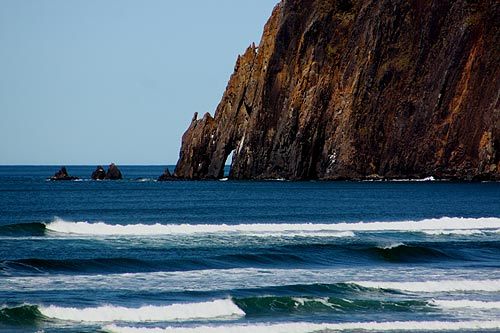
A modern view of the coast near Manzanita, near the site of the Glenesslin wreck.
The Glenesslin was only twenty-eight years old when it met its bizarre demise. Built in Liverpool, it was the pride of the C.E. DeWolf & Co. fleet and was an amazingly fast ship. But, times were growing hard for sailing due to the introduction of steam power. Sailing ships were slower, much less predictable, and far more susceptible to natural factors delaying or sometimes ruining a voyage (and its crew). Magnificent as she was, the Glenesslin had not been able to turn a profit in years.
In charge of the ship on this last voyage was Captain Owen Williams, a seasoned captain with a spotless record, and his crew of twenty people including his first and second mates, both of which were in their twenties. When the ship crashed a hole was ripped in its underside and it came to rest wedged in the rocks at the base of Neahkahnie Mountain. The crew was stuck in a destroyed ship being pummeled by surf but, thanks to the use of a rescue line, everyone aboard the ship was safely brought to shore. The crew seemed oddly calm about the ordeal, some even took the time to grab possessions before leaving the ship. The crash was a strange event, but what turned it from strange to suspicious was what wasn’t said back on shore.
Naturally, people wanted an explanation for why the Glenesslin crashed but they would find no easy answers. The crew refused to talk and Captain Williams’s few words did nothing to illuminate what went wrong. When asked what happened Williams answered “All I can say is that the boat is ashore and is a total loss.” When asked who was at the wheel at the time of the crash he only said “One of the seamen. I don’t remember his name.” Interviews were attempted but the moment the crash was brought up to the Captain they were immediately ended.
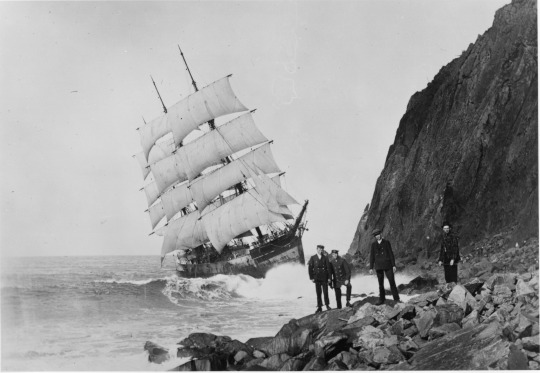
Crew members and locals posing with the wreck of the Glenesslin.
With no official explanation for the Glenesslin story, people began to fill in the blanks themselves. One theory was that the ship simply fell victim to a trap of the sea. Navigators familiar with the region claimed there was a small area, a “wind shadow” where ships could get easily trapped in a pocket of no wind. With nothing to propel the sails and ship forward, the vessel would be stuck. Some theorized that this fate befell the Glenesslin and as the crew was attempting to escape the windless pocket, the winds suddenly picked up and without enough time to react they were sent crashing into the rocks. It might have sounded like a legit claim, but if it was true why did the crew not tell that story? Was the embarrassment of landing in a wind pocket strong enough to silence the entire crew?
If the fault was not on the sea, then it was on the ship. Williams may have been a seasoned professional, but both of his first and second mates were very young at twenty-two years old. As the age of sail began to dwindle it became increasingly difficult for captains to man their ship with an experienced crew leading to sailing ships often resting in the hands of young men who took the job for all the wrong reasons. Sailing ships offered higher titles just to get working feet on deck, they developed a reputation as a stepping stone to getting a position on a steam ship, and sometimes a crew member found himself on board only after being shanghaied. This could lead to even the best captains having to deal with unexperienced and unmotivated crew members. After all, with such a shortage of sailing crew captains often had no choice but to deal with whatever workers he could get.
According to one later testimony, the Glenesslin was not experiencing the sun and clear skies often reported on that day but was actually dealing with fog. Captain Williams left the deck at 12:45pm, telling his second mate he was going to lay down and should be called upon at 2pm. When the second mate went to the captain at the decided time he told him the ship was dangerously close to the shoreline, saying “She's getting very close in." When the captain got to the deck the Neahkahnie Mountain was straight ahead giving them no choice but the head directly into it.
But, the question remains that if any of this was true, why did Captain Williams and the crew refuse to speak about what happened on the ship? The truth may lay not in their accounts, but in the words of those who met the crew on shore. According to multiple accounts when the surprisingly relaxed sailors set foot on shore they and their captain all smelled strongly of alcohol.
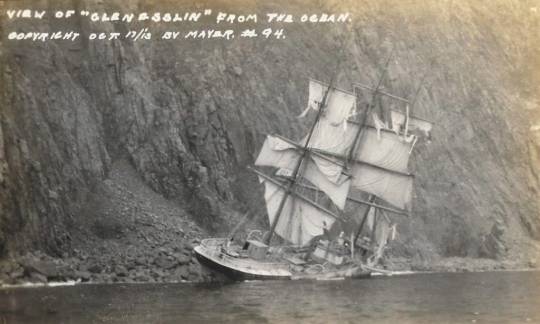
Photograph of the Glenesslin wreck taken several weeks after the crash.
While there are several theories that the wreck of the Glenesslin was accidental due to shadows, inexperience, or alcohol-fueled negligence, there is another possibility that the crash was absolutely deliberate. Captain Williams was undoubtedly aware that the Glenesslin’s days were counting down and taking his job with it. The ship had not turned a profit in years, but there was one way for the captain to get one last payday from the ship, and that was through an insurance payout.
Many factors made insurance fraud seem like an obvious motive for crashing the once famous ship. With the head on collision with the rocks the Glenesslin had a hole torn into the hull making it impossible to fix. The sails were left in place ensuring that any wind would only further press the vessel into the coastline and cause further damage. There would be no loss of cargo, the ship was empty and the exiting crew lacked the panic expected to accompany a wreck. The calm was due to the placement of the ship, it just so happen to crash in a spot that was perfectly situated for casting a lifeline to the shore ensuring their safety.
Legal hearings to determine the cause of the Glenesslin’s demise brought little clarity. Captain Williams said that he took a nap after lunch and when he was woken up the ship was already doomed to crash. After multiple tedious court proceedings it was determined that negligence brought the Glenesslin to its untimely end. The first mate was reprimanded for their lackluster response to the impending danger of the crash. The second mate’s license was suspended for six months for allowing the ship to get so close to the shore without making the captain aware of the situation earlier. Captain Williams’s license was suspended for six months under the charge of negligence. But, Williams walked away from the whole debacle with more than a six month suspension, he also pocketed an insurance check worth $30,000.
The wreck of the Glenesslin sat stranded on the rocks and was gradually picked apart by souvenir hunters and those looking to make a quick buck until it finally was sold for salvage for $560. The buyer purchased the wreck sight unseen and when they finally laid eyes on their purchase they turned around and sold it off for the sum of $100.
When the Glenesslin crashed into the coast along the Neahkahnie Mountain it created a spectacularly bizarre sight that may have been lost to time if it had not been for local photographers capturing it on film. One local man named Paul Bartels was near the scene that fateful afternoon and he happened to have his camera with him, “one of those old-timey cameras, you know the kind you have to throw the black rag over your head.” The images captured by Bartels have become iconic images of the Glenesslin crash, some showing crew members standing on the rocks with the freshly wrecked ship in the background. Today the image collection belongs to the Cannon Beach History Center and Museum.
The true cause of the Glenesslin wreck has never been determined.
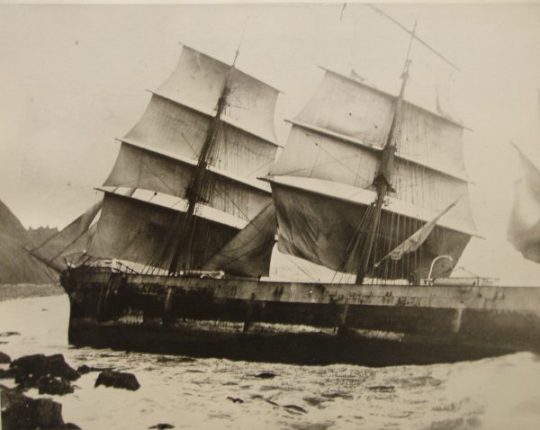
Photograph of the Glenesslin wreck taken by Paul Bartels.
#husheduphistory#featuredarticles#Oregon#Oregonhistory#shipwreck#Maritimehistory#Oregonship#Oregonshipwreck#Maritime#Mysteryatsea#HistoricConspiracy#HistoriesMysteries#thetruthisoutthere#mistake#scam#boatdrinking#daydrinking#oops#imonaboat#NeahkahnieMountain#drunkenmistake#gotawaywithit#truestory#historyiswild#histyoryisnotborning#historyisfun#historyisneat#forgottenhistory#strangehistory
1 note
·
View note
Photo

Despite what you may have heard- the holiday spirit is alive & thriving at @shoplloydcenter this year. • • • • #llyodcenter #portlandoregon #pdx #portlandphotography #portlandphotographer #pdxphotography #pdxphotographer #historicportland #portlandhistory #portlandlife #oregonhistory #historicoregon #holidayseason #holidayshopping #christmasseason #christmasshopping #christmastree #icerink #christmasdecor #december2021 #urbanphotography #holidayphotos #holidayphotography #christmasphotos #christmasphotography #shoppingmall #historicbuildings #vintagechristmas #holidayspirit (at Lloyd Center Ice Rink) https://www.instagram.com/maespringphoto/p/CXFlz8er9GO/?utm_medium=tumblr
#llyodcenter#portlandoregon#pdx#portlandphotography#portlandphotographer#pdxphotography#pdxphotographer#historicportland#portlandhistory#portlandlife#oregonhistory#historicoregon#holidayseason#holidayshopping#christmasseason#christmasshopping#christmastree#icerink#christmasdecor#december2021#urbanphotography#holidayphotos#holidayphotography#christmasphotos#christmasphotography#shoppingmall#historicbuildings#vintagechristmas#holidayspirit
0 notes
Photo




1900s Portland: Fascinating Historical Photos Show What Portland Looked Like At The Turn Of The 20th Century
#portland#northeast#Oregon#Oregonhistory#portlandhistory#1900s#20thcentury#history#vintagephotos#historyphotos#portlandarchitecture#oldhomes
0 notes
Photo

Sooo, in all my years living in Portland, I've never been to Pittock Mansion. Had a few minutes before picking up a run, so thought I'd stop in. #wow! #beautiful #stately #oregonhistory #icouldlivehere #overwhelming #nexttrip #seetheinside #gorgeousgrounds (at Pittock Mansion) https://www.instagram.com/p/CD-YCdugBc0/?igshid=2082du46v020
#wow#beautiful#stately#oregonhistory#icouldlivehere#overwhelming#nexttrip#seetheinside#gorgeousgrounds
0 notes
Photo

I LOVE living in a small town! This kind of yard "ornament", a.k.a. wagon, is truly my kind of style. Not to mention that I'm envious over the porch covered with firewood, too; I sure miss having a woodstove! #oregonhistory #easternoregon #pnwonderland #oldtimewagons #uniquelawnornaments #ontariooregon (at Ontario, Oregon)
1 note
·
View note
Photo


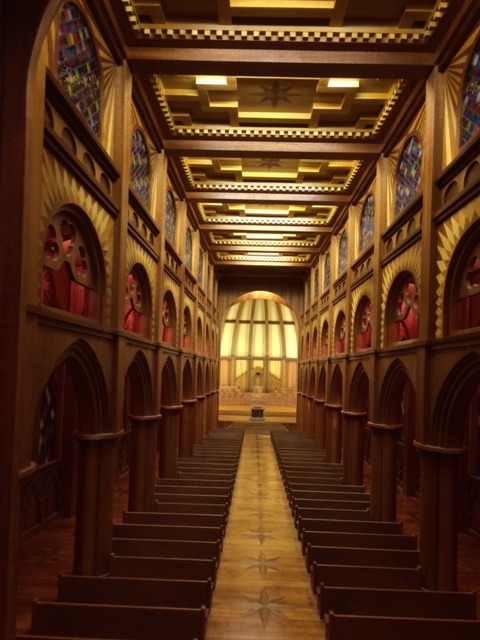
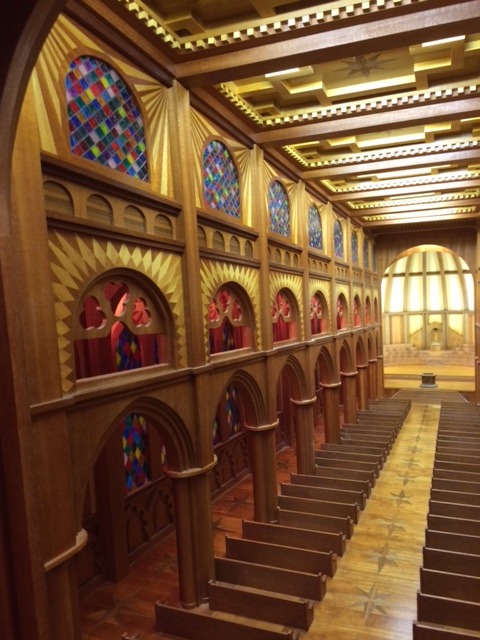



The Gresham Historical Society is currently featuring the models of Gresham mason Bruce Plumb. Come lose yourself in his surreal world!
0 notes
Photo

Main Street, Dallas Oregon (1880s). Many years later this building housed Foster's Sports Store and Dallas College of Beauty and Barbering. #dallaspubliclibrary #dallaslibraryoregon #discoverdallasor #dallasoregon #oregonhistory https://www.instagram.com/p/B5I9sV_JSrS/?igshid=i9oxdz90ozjc
0 notes
Photo

Unique companies need unique #brands. Add some personality and make your #identity stand out! . #branding #photography #portland #oregon #history #oregonhistory #kickassoregonhistory
2 notes
·
View notes
Photo

#orenburggorod #oregoneclipsefestival #oregonboy #oregongrowers #oregonstateparks #orenfransez #orecchiettepugliesi #OregonGolf #Oregonweather #orecal #oregonwaterfalls #orenishii #Oreillers #oregonjeeps #orea #oregonbeach #oregonhomeloans #oregonhistory #orenburgart #orenbayan #oregonmama #oregonhiking #oregonwild #oregun #oregonfishing #oremosporelmundo #oregonhair #oreiadulto #orecchiniuncinetto #orenburg56 (at Valles Caldera National Preserve) https://www.instagram.com/p/B3DX6emnmbw/?igshid=47gtcv805uhe
#orenburggorod#oregoneclipsefestival#oregonboy#oregongrowers#oregonstateparks#orenfransez#orecchiettepugliesi#oregongolf#oregonweather#orecal#oregonwaterfalls#orenishii#oreillers#oregonjeeps#orea#oregonbeach#oregonhomeloans#oregonhistory#orenburgart#orenbayan#oregonmama#oregonhiking#oregonwild#oregun#oregonfishing#oremosporelmundo#oregonhair#oreiadulto#orecchiniuncinetto#orenburg56
0 notes
Photo

Keith rang a bell at Ft Dalles Museum in the Columbia River Gorge. The Dalles is a small town in the Columbia River Gorge area of Oregon. Ft Dalles is a charming interactive museum, dedicated to local pioneer history. For example, the museum still has the town’s original fire alert bells. Interestedly, the different tones of the bells would alert the townspeople as to which section of town the fire was burning. @traveloregon @gorgewine #thedalles #balchhotel #ftdalles #firebells #lovehistory #pioneerhistory #oregonhistory #iloveoregon #columbiarivergorge #retireearlyandtravel #travelcouples #travelwithlove #travelwithus #travelnow #oregonphotographer #visitoregon #lovetravels #lovetravelling #smalltowns #bells #rockthebells (at Dallas, Oregon) https://www.instagram.com/p/B1jEDpOgaWN/?igshid=1pjsq6fu5yqp3
#thedalles#balchhotel#ftdalles#firebells#lovehistory#pioneerhistory#oregonhistory#iloveoregon#columbiarivergorge#retireearlyandtravel#travelcouples#travelwithlove#travelwithus#travelnow#oregonphotographer#visitoregon#lovetravels#lovetravelling#smalltowns#bells#rockthebells
0 notes
Text
Gutted by Gorse: How a Favorite Plant Almost Took a Town off the Map
When Lord George Bennett looked over the Oregon land at the mouth of the Coquille River in June 1873 he had a vision. The land was far from undiscovered holding a past filled with conflict between Native Americans and Europeans, shipwrecks, and a miniature gold rush only twenty years beforehand, but Bennett saw more. He was ambitious, he was sentimental, and one of these traits would bring his vision to ruin.
Bennett was an Irish immigrant and when he and a handful of colonists arrived in this region of southwest Oregon he envisioned a thriving community taking root, “We thought it was just the very place for a town,” he later recalled, “and that it was only a question of time when there would be a very thriving one there.” The town quickly took hold and it was named Bandon, after Bennett’s hometown of Bandon located in County Cork, Ireland. The name was not the only part of home that Bennett wanted incorporated into his new town, he also wanted his favorite shrub from Ireland planted throughout. The bush was a spiny plant called gorse and its nicknames of Irish furze and Irish hedge more than likely warmed Bennett’s heart with memories of home.

Lord George Bennett of Bandon, Ireland and Bandon, Oregon.
Bennett’s town of Bandon prospered with a post office, sawmill, school house, and a Catholic church all being built before 1885. Bandon also began a successful venture into cheese making and in 1884 the U.S Army Corp of Engineers began constructing a jetty. These were all positive steps but something else was also growing rapidly in Bandon, and residents were not as thrilled with this growth. The gorse plant brought in by Bennett became increasingly invasive, growing so thick in some parts of the town that it would fill spaces in between buildings and make alleyways impossible to pass through due to its thick wall of spiny branches. These may have been simple inconveniences, but another of the plant’s attributes went far beyond being annoying. It made it outright dangerous.

Large gorse plant.
Gorse is not only invasive, it has a chemical composition that makes its leaves extremely oily and highly flammable, reacting to fire like fuel and rendering it nearly impervious to water once ignited. Recalling his vacations to Bandon in his youth, historian Thomas McClintock experienced firsthand the terrifying combination of gorse and wildfire:
“…a fire started in the gorse which was rather frightening because of the intense heat and flames which rose a hundred feet into the air. Fortunately, on that occasion the fire was eventually brought under control with no loss of property.”
Bandon was not so lucky on September 26th 1936 when a forest fire broke out several miles east of town. At first the residents were not worried, believing that there was enough distance between them and the flames to allow them to carry on as normal. However, a shift in the wind changed everything and when the flames moved westward it spelled certain doom. As the fire moved into Bandon the gorse combusted creating a raging inferno that shot high into the air and leveled everything in its path. Firemen abandoned their gear, joining terrified residents as they ran toward the beach and the waters of the Coquille River. After all, their hoses were useless. The water sprays only scattered the flammable oil oozing from the plant which spread the flames even further and the blaze melted the tires on their fire trucks.

A view of Bandon, Oregon before the fire of 1936.
Eyewitness accounts paint a grim and hopeless picture. Resident D.H. Woomer later told a local newspaper:
“That Irish hedge was the worst thing—when the fire hit it right across from my house, the flames shot up high into the air. It was just as though there had been gasoline poured on the fire. And water was just no good against it—wouldn’t touch it! The stuff seemed just full of oil.”
Writer Stewart Holbrook described just how quickly the fire consumed everything around it, stating:
“A stray spark would fall in a green clump of gorse near a house. An instant later the gorse was flaming higher than the house. In another instant the house was wholly on fire. Time and again it happened.”
Sixty-three years after his vision was brought to life, Bennett’s new town was torn apart by the very thing he brought in to represent his old home.
The town of Bandon was crushed with over 500 buildings destroyed and only sixteen remaining in salvageable condition. Amazingly though, only ten lives were lost in the inferno, all of which were the result of people trying to get into their homes to retrieve possessions.

Aftermath of the 1936 fire of Bandon, Oregon. Image via oregonhistoryproject.org

Cars scorched by the 1936 Bandon, Oregon gorse fire. Image via offbeatoregon.com.
The rebuilding effort of Bandon, Oregon began within days after the destruction and today the quaint streets give no indication of the disaster that nearly wiped the town off the map nearly eighty-three years ago. The flames have been out for decades but one thing that is still raging through Bandon is the gorse. Still being plagued by this rampant and problematic plant, Bandon now has an official Gorse Action Group who are “working to control and reduce the spread of gorse, minimize the impact of gorse on our economy and natural resources, and provide a successful process to share with others facing gorse infestations.”

View of the Pacific Ocean and part of the Oregon Islands National Wildlife Refuge today from Coquille Point in Bandon, Oregon.
#HushedUpHistory#featuredarticles#history#Oregon#OregonHistory#Bandon#gardening#gorse#invasion#touchofhome#fire#flames#wildfire#disaster#favoriteplant#planting#dangerousplants#invasivespecies#historictown#historicOregon#fireprevention#survival#bouncedback#couldhavebeenworse#rebuilding#nature#natureyouscary#truestory#fact#truthisstrangerthanfiction
1 note
·
View note
Photo

Fort Stevens was an American military installation built near the end of the American Civil War that guarded the mouth of the Columbia River in the state of Oregon.Today the site is a state park. • • • • #fortstevens #fortstevensstatepark #fortstevensoregon #historicoregon #historicplaces #historicarchitecture #oregonexplored #oregonphotography #oregonphotographer #oregonhistory #oregonlife #oregonnw #upperleftusa #pnwdiscovered #pnwphotographer #pnwadventures #pnwphotography #historyphotographed #militaryreserve #historicamerica #traveloregon #travelphotography #visualambassadors #visitoregon #architecture_hunter #architecturephotography #moodygrams #moodyarchitecture #createexplore #samsungphotography (at Fort Stevens, Oregon) https://www.instagram.com/p/CU-fCq8JpQb/?utm_medium=tumblr
#fortstevens#fortstevensstatepark#fortstevensoregon#historicoregon#historicplaces#historicarchitecture#oregonexplored#oregonphotography#oregonphotographer#oregonhistory#oregonlife#oregonnw#upperleftusa#pnwdiscovered#pnwphotographer#pnwadventures#pnwphotography#historyphotographed#militaryreserve#historicamerica#traveloregon#travelphotography#visualambassadors#visitoregon#architecture_hunter#architecturephotography#moodygrams#moodyarchitecture#createexplore#samsungphotography
0 notes
Photo

My favorite old home in my little town. . #45thphoto #oldhouselove #oldhomes #architecturephotography #architecture #pioneerhouse #Oregon #outsideoregon #outandabout #oregonbeauty #oregonbeautiful #oregonhistory #willamettevalley #mounthoodterritory #frenchprairie #woodburnoregon #autumnalcolours #autumn #lumixusa #wherelumixgoes (at Jesse H. Settlemier House) https://www.instagram.com/p/CHKFG6GhsWb/?igshid=wb2sozbnlk9g
#45thphoto#oldhouselove#oldhomes#architecturephotography#architecture#pioneerhouse#oregon#outsideoregon#outandabout#oregonbeauty#oregonbeautiful#oregonhistory#willamettevalley#mounthoodterritory#frenchprairie#woodburnoregon#autumnalcolours#autumn#lumixusa#wherelumixgoes
0 notes
Photo

I am working away on a photomontage of The Dalles, Oregon! When I explored the town, I found a key landmark...the Fort Dalles Museum...really another hidden treasure of Oregon. The first to photos are images of the Surgeon quarters...the last standing building of the Fort Dalles Military complex’s built in 1856. And it became a museum in 1905 - possibly THE oldest museum in Oregon. It is filled with historic artifacts and history of The Dalles. It has a lot of great pieces from the Umatilla House (a major hotel in The Dalles for years, but was dismantled). They have a full collection of old cars and carriages including the Umatilla Bus, a US Postal buggy (shown), even an early Studabaker Electric car (shown)! (Even back in the day, they made electric cars!) Then I loved the “Reminder Clock”, and some of the old slot machines. There is so much there...it’s hard to cover it all! . Lastly, you can tour the Anderson homestead which is a Swedish log home built in 1895. Anderson built this on a farming property outside of The Dalles but it was preserved and placed near the Fort Dalles. It is amazing to tour also. . Another amazing example of preserved history in Oregon. . . #thedalles #thedallesoregon #fortdalles #fortdallesmuseum #beautifuloregon #historichomes #historicpreservation #traveloregon #hiddentreasure #historymuseum #museum #oregon #columbiarivergorge #treasureoforegon #oregonhistory #oregonhistorymuseum (at Fort Dalles Museum and Anderson Homestead) https://www.instagram.com/p/Bzx9xrAhAeH/?igshid=1sfkkar5cgxuy
#thedalles#thedallesoregon#fortdalles#fortdallesmuseum#beautifuloregon#historichomes#historicpreservation#traveloregon#hiddentreasure#historymuseum#museum#oregon#columbiarivergorge#treasureoforegon#oregonhistory#oregonhistorymuseum
0 notes